-
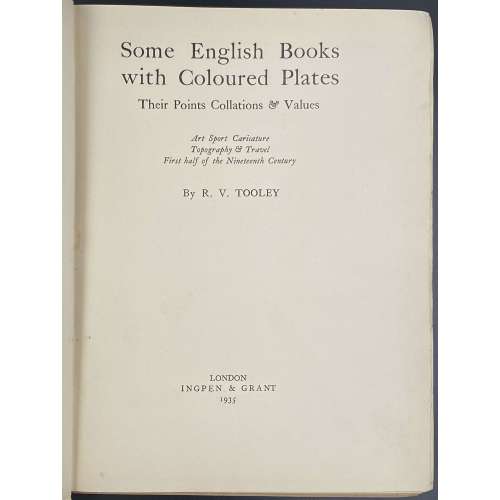 Title: Some English Books | with Coloured Plates | Their Points Collations & Values | Art Sport Caricature | Topography & Travel | First half of the Nineteenth Century | by R. V. Tooley | […] | LONDON | INGPEN & GRANT | 1935 || Pagination: [i-vi] vii-viii, [1] 2-288, Collation: 8vo, π3 A-S8. Size: 26.3 x 20.3 cm Binding: Hardcover, brown polished cloth, bevelled boards, gilt lettering to spine, TMG, other untrimmed.
Title: Some English Books | with Coloured Plates | Their Points Collations & Values | Art Sport Caricature | Topography & Travel | First half of the Nineteenth Century | by R. V. Tooley | […] | LONDON | INGPEN & GRANT | 1935 || Pagination: [i-vi] vii-viii, [1] 2-288, Collation: 8vo, π3 A-S8. Size: 26.3 x 20.3 cm Binding: Hardcover, brown polished cloth, bevelled boards, gilt lettering to spine, TMG, other untrimmed. -
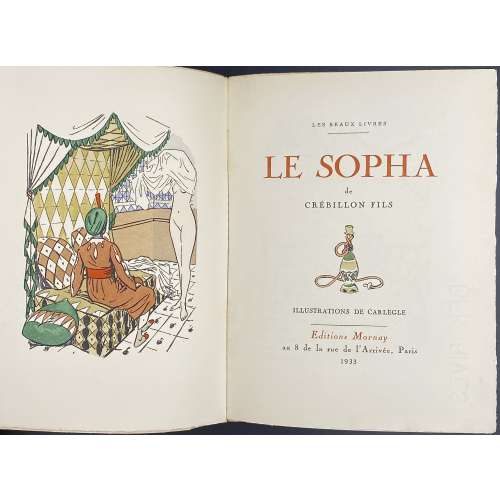 Title: LES BEAUX LIVRES | — | LE SOPHA | de | CRÉBILLON FILS |{vignette}| ILLUSTRATIONS DE CARLÈGLE | — | Éditions Mornay | au 8 de la rue de l’Arrivée, Paris | 1933 || Series: Les beaux livres Binding: Original pictorial wrappers, margins untrimmed, uncut; printed on BFK Rives paper (watermark); the number of copy blacked out. Justification of the print run on p. [329].Pagination: [1-8] 9-326 [327-331], ill., woodcuts in text. Size: 20.2 x 15.5 cm
Title: LES BEAUX LIVRES | — | LE SOPHA | de | CRÉBILLON FILS |{vignette}| ILLUSTRATIONS DE CARLÈGLE | — | Éditions Mornay | au 8 de la rue de l’Arrivée, Paris | 1933 || Series: Les beaux livres Binding: Original pictorial wrappers, margins untrimmed, uncut; printed on BFK Rives paper (watermark); the number of copy blacked out. Justification of the print run on p. [329].Pagination: [1-8] 9-326 [327-331], ill., woodcuts in text. Size: 20.2 x 15.5 cm -
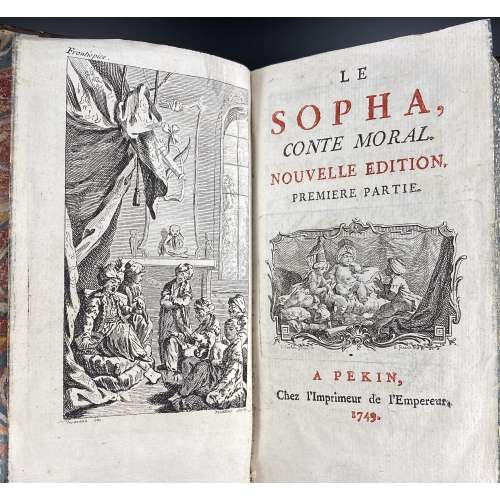 Title-page in black and red: LE | SOPHA, | CONTE MORAL. | NOUVELLE EDITION. | PREMIERE PARTIE. | {vignette} | A PEKIN, | Chez l'imprimeur de l'Empereur, | 1749. || Pagination: Two volumes in one. [2] – blanks, [2] – blank / frontis., [i, ii] – t.p. / blank, [iii] iv-xxi [xxii] ; [1] 2-253, [254-256] – table / blank, [2] – blanks; [i, ii] f.t. (seconde partie). [iii] 4-237 [238-240] – table / blank, [2] – blanks ; ills. 1 frontispiece, 4 plates and 2 vignettes by Pelletier after Clavereau, 2 fleurons by Fessard after Cochin. Collation: 12mo; a12, A8B4–T8V4, X8 [*1]; A8B4–T8V4. Binding: Full mottled calf, flat spine, compartments double-ruled in gilt, gilt flowers and foliage in compartments, crimson title label; marbled endpapers. Printed on laid paper, watermarked. Size: 14.8 x 8.8 cm Catalogue raisonné: Cohen, de Ricci (266); J. Lewine (124-5).
Title-page in black and red: LE | SOPHA, | CONTE MORAL. | NOUVELLE EDITION. | PREMIERE PARTIE. | {vignette} | A PEKIN, | Chez l'imprimeur de l'Empereur, | 1749. || Pagination: Two volumes in one. [2] – blanks, [2] – blank / frontis., [i, ii] – t.p. / blank, [iii] iv-xxi [xxii] ; [1] 2-253, [254-256] – table / blank, [2] – blanks; [i, ii] f.t. (seconde partie). [iii] 4-237 [238-240] – table / blank, [2] – blanks ; ills. 1 frontispiece, 4 plates and 2 vignettes by Pelletier after Clavereau, 2 fleurons by Fessard after Cochin. Collation: 12mo; a12, A8B4–T8V4, X8 [*1]; A8B4–T8V4. Binding: Full mottled calf, flat spine, compartments double-ruled in gilt, gilt flowers and foliage in compartments, crimson title label; marbled endpapers. Printed on laid paper, watermarked. Size: 14.8 x 8.8 cm Catalogue raisonné: Cohen, de Ricci (266); J. Lewine (124-5). -
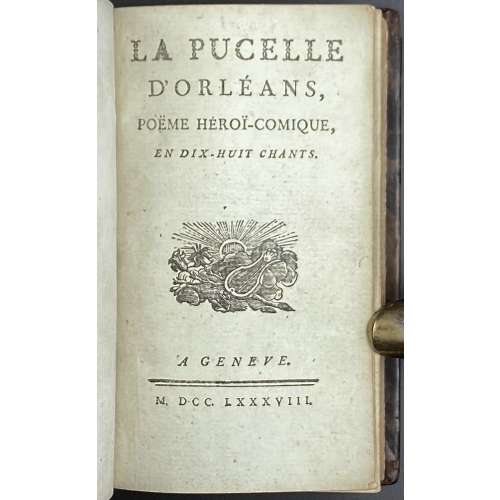 LA PUCELLE | D'ORLÉANS, | POËME HÉROÏ-COMIQUE, | EN DIX-HUIT CHANTS. |{vignette}| A GENEVE. | M. DCC.LXXXVIII.|| Pagination: engraved frontis., engraved portrait, [1, 2] – t.p. / blank, [3] 4-304; plates: engraved frontispiece, engraved portrait of Jeanne d'Arc and 18 engraved plates (the so-called 'suite anglaise' by Marillier, Clément-Pierre (French, 1740 – 1808) after Duflos, Pierre (French, 1742 – 1816). Publisher: Cazin, Hubert-Martin (French, 1724 – 1795). Modern binding to imitate full mottled calf of the 18th century, gilt double-ruled boards, gilt decorated spine with the crimson label “LA PUCELLE”, AEG, laid paper. Size: 13.3 x 8.7 cm; 18mo. Catalogue raisonné: Cohen, De Ricci 1032 (for 1777 and 1780 editions). J. Lewine p.559 (for 1777 16mo and even 12mo editions). The 'correct' 1st thus edition is called suite anglaise because instead of 'chant number' it's printed 'book number' on top of the pages. This copy is definitely a later pirated edition.
LA PUCELLE | D'ORLÉANS, | POËME HÉROÏ-COMIQUE, | EN DIX-HUIT CHANTS. |{vignette}| A GENEVE. | M. DCC.LXXXVIII.|| Pagination: engraved frontis., engraved portrait, [1, 2] – t.p. / blank, [3] 4-304; plates: engraved frontispiece, engraved portrait of Jeanne d'Arc and 18 engraved plates (the so-called 'suite anglaise' by Marillier, Clément-Pierre (French, 1740 – 1808) after Duflos, Pierre (French, 1742 – 1816). Publisher: Cazin, Hubert-Martin (French, 1724 – 1795). Modern binding to imitate full mottled calf of the 18th century, gilt double-ruled boards, gilt decorated spine with the crimson label “LA PUCELLE”, AEG, laid paper. Size: 13.3 x 8.7 cm; 18mo. Catalogue raisonné: Cohen, De Ricci 1032 (for 1777 and 1780 editions). J. Lewine p.559 (for 1777 16mo and even 12mo editions). The 'correct' 1st thus edition is called suite anglaise because instead of 'chant number' it's printed 'book number' on top of the pages. This copy is definitely a later pirated edition. -
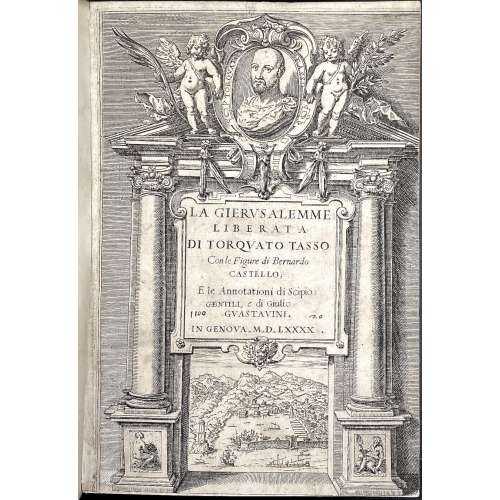 Engraved title with the portrait of Torquato Tasso, displayed in an oval medallion, bound in “TORQUATO TASSO”, between two naked putti; Architecture with two columns and Ionic capitals supporting an architectural pediment; between the columns is a table with the inscription: LA GIERVSALEMME | LIBERATA | DI TORQVATO TASSO | Con le Figure di Bernardo | CASTELLO; | E le Annotazioni di Scipio | GENTILI, e di Giulio | GVASTAVINI. | IN GENOVA. M.D.LXXXX .|| Contents: The 20 cantos are followed by: Tutte le stanza intere, che dall'autore sono state refiutate in questo libro; Annotationi di Scipio Gentili; Luoghi osservati dal mag. Giulio Guastavini, quali il Tasso nella sua Gierusalemme hà presi & imitati da poeti & altri scrittori antichi; Allegoria del poema; Tavola di tutti i nomi proprii et di tutte le materie principali contenute nel presente libro. Pagination: [2] engraved t.p. / blank, 3-11, [1] 2-255 [256], 1-71 [72] [1] 2-40, 4 unpag. leaves ‘Allegoria del poema’; total 387 pp. Collation: 8vo; π6 A-Q8 A-D8 E4 A-B8 χ4 (in the first quire M4 marked L4), ills. signed in collation. At p. 17 canto 3rd marked as 2nd, pp. 135 and 139 in 12th canto marked as 11th. Binding: later full polished calf, blind double-ruled covers, blind double-ruled raised bands, gilt lettering: GIERVSALEMME | LIBERATA and GENOVA | 1590. TMG. Printed on laid paper. Front joints split at head and tail. Title page and twenty full-page ill. facing the opening of each canto, engraved by Agostino Carracci and Giacomo Franco after Castello. Those for cantos 6-8, 10, 12, 16-17, 19-20 are by Carracci, 8 and 19 with his initials. The remainder are by Franco and are signed by him. Woodcut head and tailpieces, the Argomenti at the head of each canto within cartouches, initials. Catalogue raisonné: Adam Bartsch. Le peintre graveur. — Vienne: J. V. Degen, 1803.
Engraved title with the portrait of Torquato Tasso, displayed in an oval medallion, bound in “TORQUATO TASSO”, between two naked putti; Architecture with two columns and Ionic capitals supporting an architectural pediment; between the columns is a table with the inscription: LA GIERVSALEMME | LIBERATA | DI TORQVATO TASSO | Con le Figure di Bernardo | CASTELLO; | E le Annotazioni di Scipio | GENTILI, e di Giulio | GVASTAVINI. | IN GENOVA. M.D.LXXXX .|| Contents: The 20 cantos are followed by: Tutte le stanza intere, che dall'autore sono state refiutate in questo libro; Annotationi di Scipio Gentili; Luoghi osservati dal mag. Giulio Guastavini, quali il Tasso nella sua Gierusalemme hà presi & imitati da poeti & altri scrittori antichi; Allegoria del poema; Tavola di tutti i nomi proprii et di tutte le materie principali contenute nel presente libro. Pagination: [2] engraved t.p. / blank, 3-11, [1] 2-255 [256], 1-71 [72] [1] 2-40, 4 unpag. leaves ‘Allegoria del poema’; total 387 pp. Collation: 8vo; π6 A-Q8 A-D8 E4 A-B8 χ4 (in the first quire M4 marked L4), ills. signed in collation. At p. 17 canto 3rd marked as 2nd, pp. 135 and 139 in 12th canto marked as 11th. Binding: later full polished calf, blind double-ruled covers, blind double-ruled raised bands, gilt lettering: GIERVSALEMME | LIBERATA and GENOVA | 1590. TMG. Printed on laid paper. Front joints split at head and tail. Title page and twenty full-page ill. facing the opening of each canto, engraved by Agostino Carracci and Giacomo Franco after Castello. Those for cantos 6-8, 10, 12, 16-17, 19-20 are by Carracci, 8 and 19 with his initials. The remainder are by Franco and are signed by him. Woodcut head and tailpieces, the Argomenti at the head of each canto within cartouches, initials. Catalogue raisonné: Adam Bartsch. Le peintre graveur. — Vienne: J. V. Degen, 1803.Author: Written by Torquato Tasso (Italian, Sorrento 1544–1595 Rome)
Designer: Illustrations designed by Bernardo Castello (Italian, Genoa (?) 1557–1629 Genoa)
Engraver: Illustrations engraved by Agostino Carracci (Italian, Bologna 1557–1602 Parma)
Engraver: Illustrations engraved by Giacomo Franco (Italian, Venice 1550–1620 Venice)
Publisher: Published by Girolamo Bartoli , Genoa
Ref.: MET, HathiTrust, -
 Half-title: THE WORKS | OF | GEORGE CRUIKSHANK | CLASSIFIED AND ARRANGED.|| Title: (in black and red) THE WORKS | OF | GEORGE CRUIKSHANK | CLASSIFIED AND ARRANGED | WITH REFERENCES TO REID'S CATALOGUE | AND THEIR APPROXIMATE VALUES| BY | CAPTN. R. J. H. DOUGLAS | WITH A FRONTISPIECE | (a facsimile of the frontispiece to the rare Holiday Grammar) | LONDON | PRINTED BY J. DAVY & SONS AT THE DRYDEN PRESS 137 LONG ACRE | AND SOLD BY MESSRS. H. SOTHERAN & CO. 140 STRAND AND 37 PICADILLY ; PICKERING & CATTO | 66 HAYMARKET ; ROBSON & CO 23 COVENTRY STREET ; F. T. SABIN 118 SHAFTESBURY AVENUE ; | W. T. SPENSER 27 NEW OXFORD STREET ; AND CHARLES SCRIBNER’S SONS NEW YORK. | MDCCCCIII || Imprint (title verso): One Thousand Copies of this book have been printed and the type distributed. This is No. 205. Bookplate to recto ffl: Reference Library of Francis Edwards Ltd. Not for sale. Inscription to recto ffl: “With the author’s compliments”. Pagination: ffl, [i, ii] – h.t. / blank, [2] – blank / frontis., [iii, iv] – t.p. (black and red) / Print run, [v] v-vi –preface, [2] – contents, [2] – f.t. / note; [1] 2-301 [302] – colophon; insert one sheet with type writing on Francis Edwards letterhead, bfl. (OCLC: ix, 302 pages : illustrations ; 26 cm) Collation: [A]5 B-T8 U7 Binding: Hardcover, burgundy cloth gilt-stamped with title and publisher’s device to front board and gilt lettering to spine.
Half-title: THE WORKS | OF | GEORGE CRUIKSHANK | CLASSIFIED AND ARRANGED.|| Title: (in black and red) THE WORKS | OF | GEORGE CRUIKSHANK | CLASSIFIED AND ARRANGED | WITH REFERENCES TO REID'S CATALOGUE | AND THEIR APPROXIMATE VALUES| BY | CAPTN. R. J. H. DOUGLAS | WITH A FRONTISPIECE | (a facsimile of the frontispiece to the rare Holiday Grammar) | LONDON | PRINTED BY J. DAVY & SONS AT THE DRYDEN PRESS 137 LONG ACRE | AND SOLD BY MESSRS. H. SOTHERAN & CO. 140 STRAND AND 37 PICADILLY ; PICKERING & CATTO | 66 HAYMARKET ; ROBSON & CO 23 COVENTRY STREET ; F. T. SABIN 118 SHAFTESBURY AVENUE ; | W. T. SPENSER 27 NEW OXFORD STREET ; AND CHARLES SCRIBNER’S SONS NEW YORK. | MDCCCCIII || Imprint (title verso): One Thousand Copies of this book have been printed and the type distributed. This is No. 205. Bookplate to recto ffl: Reference Library of Francis Edwards Ltd. Not for sale. Inscription to recto ffl: “With the author’s compliments”. Pagination: ffl, [i, ii] – h.t. / blank, [2] – blank / frontis., [iii, iv] – t.p. (black and red) / Print run, [v] v-vi –preface, [2] – contents, [2] – f.t. / note; [1] 2-301 [302] – colophon; insert one sheet with type writing on Francis Edwards letterhead, bfl. (OCLC: ix, 302 pages : illustrations ; 26 cm) Collation: [A]5 B-T8 U7 Binding: Hardcover, burgundy cloth gilt-stamped with title and publisher’s device to front board and gilt lettering to spine. -
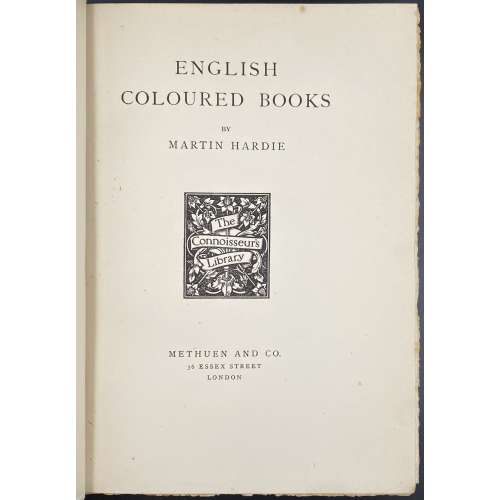 Half-title: THE CONNOISSEURS LIBRARY | GENERAL EDITOR : CYRIL DAVENPORT | […] | ENGLISH COLOURED BOOKS || Title: ENGLISH | COLOURED BOOKS | BY | MARTIN HARDIE | [device: THE CONNOISSEURS LIBRARY] | METHUEN AND CO. | 36 ESSEX STREET | LONDON || Dedication: TO MY WIFE | LOVE’S LABOUR : LOVE’S GIFT Pagination: ffl [i, ii] – h.t. / blank, [2] – blank / frontis. In colour, [iii, iv] – t.p. / First Published in 1906, [v, vi] – dedication / blank, vii-xxiv; 1-339 [340] bfl; 27 sheets of plates, colour and b/w. Collation: 8vo; a8 b4 A-X8 Y2. Binding: Hardcover, 26.3 x 19 x 5.7 cm; red cloth, blind-stamped with repeated fleuron, gilt floral designs and lettering in the frame to front cover, elaborate gilt floral design and lettering to spine; top margin gilt, other untrimmed, some pages uncut; plates w/guards. Printed on laid paper. Printed in Scotland by T. and A. Constable, at the Edinburgh university press. Contributors: Martin Hardie (British, 1875 – 1952) – Author Cyril Davenport (British, 1848 – 1941) – Editor of the series Sir Algernon Methuen (British, 1856 – 1924) – Publisher Thomas Constable (British, 1812 – 1881); Archibald Constable (British, 1774 – 1827) – Founders of the Publishing House "T. and A. Constable".
Half-title: THE CONNOISSEURS LIBRARY | GENERAL EDITOR : CYRIL DAVENPORT | […] | ENGLISH COLOURED BOOKS || Title: ENGLISH | COLOURED BOOKS | BY | MARTIN HARDIE | [device: THE CONNOISSEURS LIBRARY] | METHUEN AND CO. | 36 ESSEX STREET | LONDON || Dedication: TO MY WIFE | LOVE’S LABOUR : LOVE’S GIFT Pagination: ffl [i, ii] – h.t. / blank, [2] – blank / frontis. In colour, [iii, iv] – t.p. / First Published in 1906, [v, vi] – dedication / blank, vii-xxiv; 1-339 [340] bfl; 27 sheets of plates, colour and b/w. Collation: 8vo; a8 b4 A-X8 Y2. Binding: Hardcover, 26.3 x 19 x 5.7 cm; red cloth, blind-stamped with repeated fleuron, gilt floral designs and lettering in the frame to front cover, elaborate gilt floral design and lettering to spine; top margin gilt, other untrimmed, some pages uncut; plates w/guards. Printed on laid paper. Printed in Scotland by T. and A. Constable, at the Edinburgh university press. Contributors: Martin Hardie (British, 1875 – 1952) – Author Cyril Davenport (British, 1848 – 1941) – Editor of the series Sir Algernon Methuen (British, 1856 – 1924) – Publisher Thomas Constable (British, 1812 – 1881); Archibald Constable (British, 1774 – 1827) – Founders of the Publishing House "T. and A. Constable". -
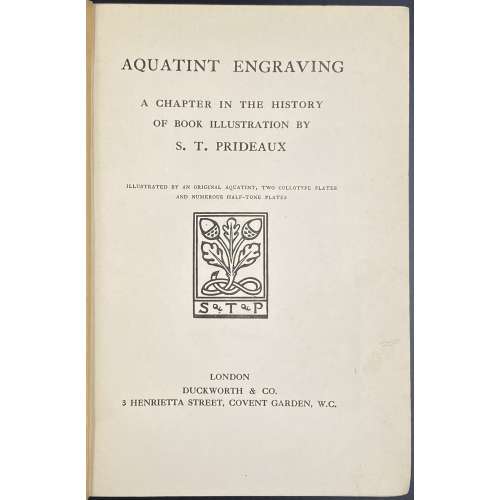 Half-title: AQUATINT ENGRAVING || Title: AQUATINT ENGRAVING | A CHAPTER IN THE HISTORY | OF BOOK ILLUSTRATION BY | S. T. PRIDEAUX | ILLUSTRATED BY AN ORIGINAL AQUATINT, TWO COLLOTYPE PLATES | AND NUMEROUS HALF-TONE PLATES | [Prideaux device] | LONDON | DUCKWORTH & CO. | 3 HENRIETTA STREET, COVENT GARDEN, W.C. || Pagination: ffl, [i, ii] – h.t. / blank, [2] – blank / frontis. w/guard, [iii, iv] – t.p. / coloph. "First Published, December 1909", [v, vi] – dedication "TO MY FATHER" / blank, vii-xv [xvi], [1] 2-434, bfl, + 24 pl. (incl. port). Collation: [a]6 b8 A-Z8 2A-2C8 2D4 Binding: Original navy cloth, gilt-ruled and lettered front board, gilt lettering to spine, a blind device to back board; upper margin gilt, free margin untrimmed. Author: Sarah Prideaux. "Engravers and the books they illustrated": p. 388-405. "Publications by Ackermann with aquatint plates": p. 374-378. "Biographical notices of engravers whose names appear on the plates": p. 358-371. "Books published before 1830 with aquatint plates": p. 325-357.
Half-title: AQUATINT ENGRAVING || Title: AQUATINT ENGRAVING | A CHAPTER IN THE HISTORY | OF BOOK ILLUSTRATION BY | S. T. PRIDEAUX | ILLUSTRATED BY AN ORIGINAL AQUATINT, TWO COLLOTYPE PLATES | AND NUMEROUS HALF-TONE PLATES | [Prideaux device] | LONDON | DUCKWORTH & CO. | 3 HENRIETTA STREET, COVENT GARDEN, W.C. || Pagination: ffl, [i, ii] – h.t. / blank, [2] – blank / frontis. w/guard, [iii, iv] – t.p. / coloph. "First Published, December 1909", [v, vi] – dedication "TO MY FATHER" / blank, vii-xv [xvi], [1] 2-434, bfl, + 24 pl. (incl. port). Collation: [a]6 b8 A-Z8 2A-2C8 2D4 Binding: Original navy cloth, gilt-ruled and lettered front board, gilt lettering to spine, a blind device to back board; upper margin gilt, free margin untrimmed. Author: Sarah Prideaux. "Engravers and the books they illustrated": p. 388-405. "Publications by Ackermann with aquatint plates": p. 374-378. "Biographical notices of engravers whose names appear on the plates": p. 358-371. "Books published before 1830 with aquatint plates": p. 325-357. -
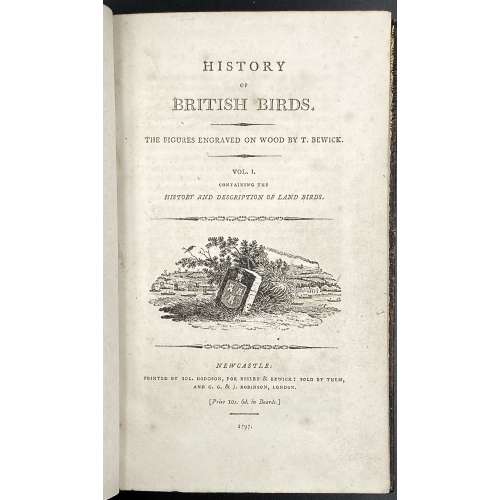 Volume 1: Title: HISTORY | OF | BRITISH BIRDS. | THE FIGURES ENGRAVED ON WOOD BY T. BEWICK. | VOL. I. | CONTAINING THE | HISTORY AND DESCRIPTION OF LAND BIRDS. | [Vignette] | NEWCASTLE: | PRINTED BY SOL. HODGSON, FOR BEILBY & BEWICK : SOLD BY THEM, | AND G. G. & J. ROBINSON, LONDON. | [Price 10s 6d. in Boards] | 1797|| Pagination: [2 blanks], [i, ii] – t.p. / blank, [iii] iv-xxx, [2] – f.t. / blank, [1] 2-335 [336 advert.] [2 blanks]; vignettes on t.p.'s; head- and tail-pieces; publisher's advertisement on final p. of v. 1. Collation: demi 8vo; a-b8, B-Y8; no sigs. A, p. 279 numbered correctly. Woodcuts: 140 descriptions of birds, 117 figures of birds, 91 vignettes, tail-pieces, etc. 1,000 copies printed. Variant B with a vignette at p. 22 printed vertically. Vignette at p. 285 without bars. Volume 2: Title: HISTORY | OF | BRITISH BIRDS. | THE FIGURES ENGRAVED ON WOOD BY T. BEWICK. | VOL. I. | CONTAINING THE | HISTORY AND DESCRIPTION OF WATER BIRDS. | [Vignette] | NEWCASTLE: | PRINTED BY EDWARD WALKER, FOR T. BEWICK : SOLD BY HIM, AND | LONGMAN AND REES, LONDON. | [Price 12s in Boards] | 1804|| Pagination: [2 blanks], [i, ii] – t.p. / blank; [iii] iv-xx, [1] 2-400, [2 blanks]. Collation: Demy 8vo in fours; a2 b-c4, A-3D4; E2, P2, Cc2 insigned. Woodcuts: 144 descriptions of birds, 101 figures of birds, 136 vignettes, tail-pieces, etc. Variant C: Vignette on p. 136 in 1st state, vignettes on pp. 269 and 359 in 2nd state. Binding: speckled full brown calf (restored), contemporary boards ruled in gilt, later spine with raised bands, gilt lettering and florets in compartments, marbled endpapers; 261 woodcut illustrations; printed on wove paper. In both volumes: armorial bookplate of "Clark, Knedlington, Yorks." with the motto "The time will come" on the front pastedown. Size: 21.5 x 14 cm, page: 20.6 x 12.6 cm, demi 8vo. Catalogue raisonné: Hugo (1866): № (99) 94 –120 (108) / pp. 40-58; Roscoe (1953): № 14 a-d, 17 a-d / pp. 46-52 and 65-76. See later edition in this collection: LIB-0860.2015.
Volume 1: Title: HISTORY | OF | BRITISH BIRDS. | THE FIGURES ENGRAVED ON WOOD BY T. BEWICK. | VOL. I. | CONTAINING THE | HISTORY AND DESCRIPTION OF LAND BIRDS. | [Vignette] | NEWCASTLE: | PRINTED BY SOL. HODGSON, FOR BEILBY & BEWICK : SOLD BY THEM, | AND G. G. & J. ROBINSON, LONDON. | [Price 10s 6d. in Boards] | 1797|| Pagination: [2 blanks], [i, ii] – t.p. / blank, [iii] iv-xxx, [2] – f.t. / blank, [1] 2-335 [336 advert.] [2 blanks]; vignettes on t.p.'s; head- and tail-pieces; publisher's advertisement on final p. of v. 1. Collation: demi 8vo; a-b8, B-Y8; no sigs. A, p. 279 numbered correctly. Woodcuts: 140 descriptions of birds, 117 figures of birds, 91 vignettes, tail-pieces, etc. 1,000 copies printed. Variant B with a vignette at p. 22 printed vertically. Vignette at p. 285 without bars. Volume 2: Title: HISTORY | OF | BRITISH BIRDS. | THE FIGURES ENGRAVED ON WOOD BY T. BEWICK. | VOL. I. | CONTAINING THE | HISTORY AND DESCRIPTION OF WATER BIRDS. | [Vignette] | NEWCASTLE: | PRINTED BY EDWARD WALKER, FOR T. BEWICK : SOLD BY HIM, AND | LONGMAN AND REES, LONDON. | [Price 12s in Boards] | 1804|| Pagination: [2 blanks], [i, ii] – t.p. / blank; [iii] iv-xx, [1] 2-400, [2 blanks]. Collation: Demy 8vo in fours; a2 b-c4, A-3D4; E2, P2, Cc2 insigned. Woodcuts: 144 descriptions of birds, 101 figures of birds, 136 vignettes, tail-pieces, etc. Variant C: Vignette on p. 136 in 1st state, vignettes on pp. 269 and 359 in 2nd state. Binding: speckled full brown calf (restored), contemporary boards ruled in gilt, later spine with raised bands, gilt lettering and florets in compartments, marbled endpapers; 261 woodcut illustrations; printed on wove paper. In both volumes: armorial bookplate of "Clark, Knedlington, Yorks." with the motto "The time will come" on the front pastedown. Size: 21.5 x 14 cm, page: 20.6 x 12.6 cm, demi 8vo. Catalogue raisonné: Hugo (1866): № (99) 94 –120 (108) / pp. 40-58; Roscoe (1953): № 14 a-d, 17 a-d / pp. 46-52 and 65-76. See later edition in this collection: LIB-0860.2015. -
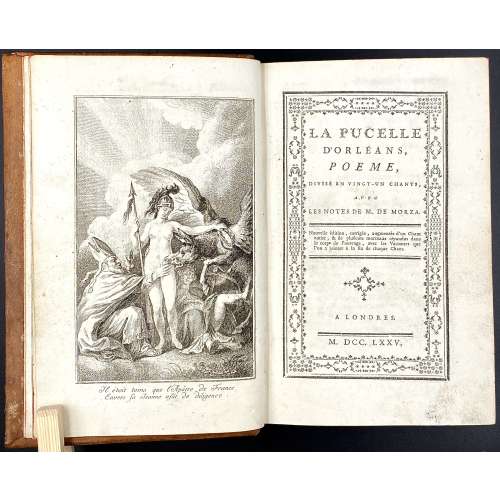 Half title: LA PUCELLE | D’ORLEANS.|| Title: LA PUCELLE | D’ORLEANS , | POEME , | DIVISÉ EN VINGT-UN CHANTS , AVEC | LES NOTES DE M. DE MORZA. | Nouvelle édition, corrigée, augmentée d'un Chant | entier, & de plusieurs morceaux répandus dans | le corps de l'ouvrage, avec les Variantes que | l'on a jointes à la fin de chaque Chant. | [ornament] | A LONDRES. |—| M. DCC. LXXV. || Pagination : [4] – two blank unnumbered fly leaves, [i,ii] – h.t. / double-ruled blank leaf, [2] – blank / frontispiece on verso, [iii, iv] – t.p. ruled and bordered / double-ruled blank leaf, [v]vi-viii – table, ix-xv – preface, [xvi] – double-ruled blank leaf, [1]2-447 [448] – double-ruled blank leaf, [2] – two blank unnumbered fly leaves; page 14 misnumbered 18; title within ornamental border; text within double-ruled borders; head- and tail-pieces; 22 leaves of plates (frontis. + one before each chant.) Collation: 8vo; a8 A-Z8 Aa-Ee8 Binding: 19.9 x 13.2 cm; full contemporary brown calf, blind ruled plates, spine with raised bands, gilt-ruled and tooled in compartments, red label with gilt lettering, all edges red; plate for chant 6, H4, H5 - separated from the block. De Morza is Voltaire (Cf. Quérard, v. 10, p. 306). Engravings unsigned; attributed to Desrais, Claude-Louis (French, 1746 – 1816). False imprint; possibly printed in Paris.
Half title: LA PUCELLE | D’ORLEANS.|| Title: LA PUCELLE | D’ORLEANS , | POEME , | DIVISÉ EN VINGT-UN CHANTS , AVEC | LES NOTES DE M. DE MORZA. | Nouvelle édition, corrigée, augmentée d'un Chant | entier, & de plusieurs morceaux répandus dans | le corps de l'ouvrage, avec les Variantes que | l'on a jointes à la fin de chaque Chant. | [ornament] | A LONDRES. |—| M. DCC. LXXV. || Pagination : [4] – two blank unnumbered fly leaves, [i,ii] – h.t. / double-ruled blank leaf, [2] – blank / frontispiece on verso, [iii, iv] – t.p. ruled and bordered / double-ruled blank leaf, [v]vi-viii – table, ix-xv – preface, [xvi] – double-ruled blank leaf, [1]2-447 [448] – double-ruled blank leaf, [2] – two blank unnumbered fly leaves; page 14 misnumbered 18; title within ornamental border; text within double-ruled borders; head- and tail-pieces; 22 leaves of plates (frontis. + one before each chant.) Collation: 8vo; a8 A-Z8 Aa-Ee8 Binding: 19.9 x 13.2 cm; full contemporary brown calf, blind ruled plates, spine with raised bands, gilt-ruled and tooled in compartments, red label with gilt lettering, all edges red; plate for chant 6, H4, H5 - separated from the block. De Morza is Voltaire (Cf. Quérard, v. 10, p. 306). Engravings unsigned; attributed to Desrais, Claude-Louis (French, 1746 – 1816). False imprint; possibly printed in Paris. -
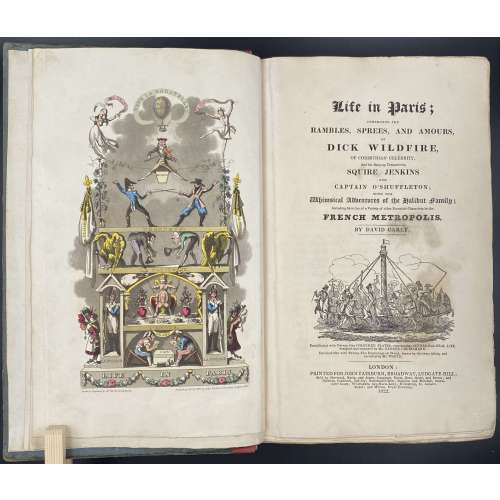
Title: Life in Paris ; | COMPRISING THE | RAMBLES, SPREES, AND AMOURS, | OF | DICK WILDFIRE, | OF CORINTHIAN CELEBRITY, | And his Bang-up Companions, SQUARE JENKINS | AND | CAPTAIN O’SHUFFLETON ; | WITH THE | Whimsical Adventures of the Halibut family ; | Including Sketches of a Variety of other Eccentric Characters in the | FRENCH METROPOLIS. | BY DAVID CAREY |[Vignette]| Embellished with Twenty-One COLOURED PLATES, representing SCENES from REAL LIFE, | designed and engraved by Mr. GEORGE CRUIKSHANK. | Enriched also with Twenty-Two Engravings on Wood, drawn by the same Artist, and | executed by Mr. WHITE. | LONDON : | PRINTED FOR JOHN FAIRBURN, BROADWAY, LUDGATE HILL; | Sold by Sherwood, Neely, and Jones ; Langman, Hurst, Rees, Orme, and Brown ; and | Baldwin, Craddoc, and Joy ; Paternoster-Row ; Simpkin and Marshall, Statio- | ners’ Court ; Whittakers Ave-Maria-Lane ; Humphrey, St. James’s | Street ; and Wilson, Royal Exchange. | 1822. ||
Edition: 1st edition in book form, 1st issue; large-paper copy bound from the parts in original blue paper boards, "most scarce" (Cohn).
Pagination: ffl, [i, ii] – h.t. ‘LIFE IN PARIS’ / ‘MARCHANT, Printer, Ingram-Court, London’, [2] – blank / Frontispiece (Ville la Bagatelle!!) hand-coloured, [iii, iv] – t.p. with vignette / blank, [v] vi-xxiv, [1] 2-489 [490 blank], [2] – 'TO THE BINDER' and 'Marchant, Printer, Ingram-Court, Fenchurch Street' "considered indispensable to a complete copy" (Cohn) / blank, bfl watermarked 1800; 21 hand-coloured aquatints and 22 wood-engraved text vignettes; cancelled leaves 143/4 and 335/6; pinholes from printing visible in most gatherings.
Collation: 4to; [a]-c4, B-Z4 Aa-Zz4 3A-3Q4 3R1 + [Ω]1
Binding: Original boards sometime re-backed with red paper, binder's end leaf watermarked 1800; red hard-grained morocco clamshell box.
Catalogue raisonné: Albert M. Cohn, 1924: № 109 p. 37/8; Abbey, J. R. (Life in England), 112; Tooley (Some English Books with Coloured Plates) 129; Hardie (English coloured books) 199.
Description of Shapero Rare Books, London: Of the copies that have come to auction since 1975 only one has been a large-paper copy in original boards. "The pictures are extremely spirited and true and are all the more wonderful in view of the fact that the artist’s continental experiences were limited to one day spent in Boulogne." (Hardie). In 1821, the journalist Pierce Egan published Life in London, an immediate success illustrated by the Cruikshank brothers, George and Robert. In order to capitalise on this success, another journalist, David Carey, decided to publish his own Life in Paris in monthly instalments (just like Life in London) and with a very similar frontispiece to the one that appears in Egan’s work; Life in Paris, however, was illustrated only by George Cruikshank. One of the earliest and most notable examples of the work of George Cruikshank, with fine, clean plates. -
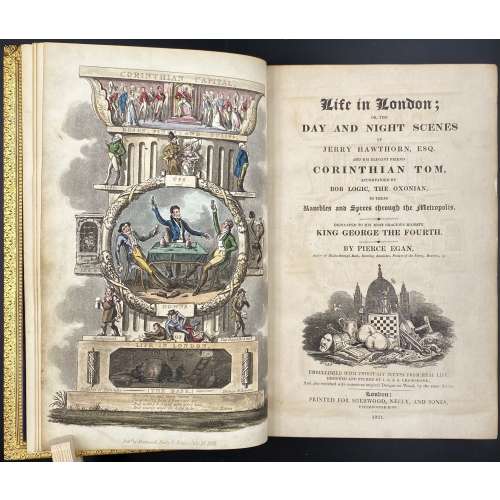
Title: Life in London ; | DAY AND NIGHT SCENES | OF | JERRY HAWTHORN, ESQ. | AND HIS ELEGANT FRIEND | CORINTHIAN TOM, | ACCOMPANIED BY | BOB LOGIC, THE OXONIAN, | IN THEIR |Rambles and Sprees through the Metropolis. | DEDICATED TO HIS MOST GRACIOUS MAJESTY | KING GEORGE THE FOURTH. | BY PIERCE EGAN, | Author of Walks through Bath, Sporting Anecdotes, Picture of the Fancy, Boxiana, &c. | [Vignette] | EMBELLISHED WITH THIRTY-SIX SCENES FROM REAL LIFE, | DESIGNED AND ETCHED BY I. R. & G. CRUIKSHANK ; | And also enriched with numerous original Designs on Wood, by the same Artists, | London: | PRINTED FOR SHERWOOD, NEELY, AND JONES, | PATERNOSTER-ROW. | 1821. ||
Edition: 1st edition, 1st issue: the first sheet of music is not numbered, absence of any footnote at page 9 (as per Cohn).
Pagination: 3 binder's flyleaves with a specimen of George Cruikshank's signature of Nov. 5th, 1860 to the first one; hand-coloured aquatint frontispiece facing the title page with blank recto, [iii-iv] – t.p. with vignette/ blank, [v] vi-viii – dedication, ix-xii – contents, [xiii]-xvi – list of illustrations; [1] 2-376; 35 hand-coloured aquatints, 3 folding leaves of music; bound without half-title [missing pp. i, ii], advertisements or 'to the subscribers' leaf.
Collation: 8vo; [A]7 B-Z8 Aa8-Bb4.
Binding: Full polished calf gilt by Rivière & Son, covers with triple gilt border, spine in 6 compartments, brown morocco lettering pieces to second and third, others richly gilt, raised bands, all edges gilt; neatly re-backed preserving spine.
Catalogue raisonné: Albert M. Cohn, 1924: № 262 p. 90; Abbey, J. R. (Life in England), 281; Tooley (Some English Books with Coloured Plates) 196; Prideaux (Aquatint Engraving) pp. 307, 310; Hardie (English coloured books) 197.
Description of Shapero Rare Books, London: There was a translation into French. At least six plays were based on Egan's characters, contributing to yet more sales. One of these was exported to America, launching the Tom and Jerry craze there. The version created by William Thomas Moncrieff was praised as The Beggar's Opera of its day. Moncrieff's production of Tom and Jerry, or Life in London ran continuously at the Adelphi Theatre for two seasons and it was the dramatist's work as much as the author's that did so much to popularise the book's trademark use of fashionable slang. In 1821 Egan announced the publication of a regular journal: Life in London, appearing monthly at a shilling a time. It was to be illustrated by George Cruikshank (1792 – 1878), and was dedicated to the King, George IV, who at one time had received Egan at court. The first edition of Life in London appeared on 15 July 1821. Egan's creation was an instant success. Pirate versions appeared, featuring such figures as 'Bob Tallyho', 'Dick Wildfire' and the like. Printmakers speedily knocked off cuts featuring the various 'stars' and the real-life public flocked to the 'sporting' addresses that Egan had his heroes frequent. -
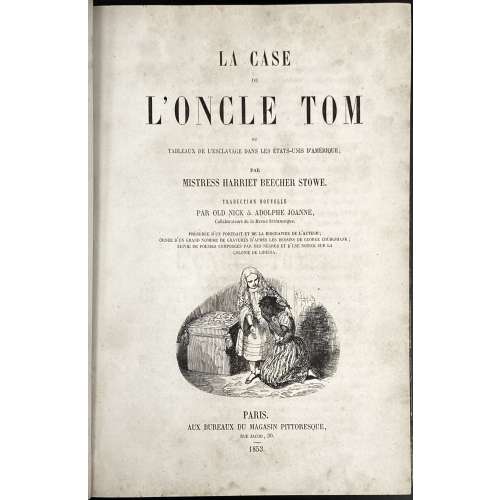 1st French edition (Paris, 1853) of Harriet Beecher Stowe's book Uncle Tom's Cabin; or, Life Among the Lowly, with 27 illustrations on wood by George Cruikshank (British, 1792 – 1878), translated into French by Paul-Émile Daurand-Forgues [pseudonym Old Nick] (French, 1813 – 1883) and Adolphe Joanne (French, 1813 – 1881). Title: LA CASE | DE | L'ONCLE TOM | OU | TABLE AUX DE L'ESCLAVAGE DANS LES ÉTATS-UNIS D'AMÉRIQUE ; | PAR MISTRESS HARRIET BEECHER STOWE. | TRADUCTION NOUVELLE | PAR OLD NICK & ADOLPHE JOANNE, | Collaboarteurs de la Revue britannique, | PRÉCÉDÉE D'UN PORTRAIT ET DE LA BIOGRAPHIE DE L'AUTEUR; | ORNÉE D'IU GRAND NOMBRE DE GRAVURES D'APRES LES DESSINS DE GEORGE CRUIKSHANK ; | SUIVIE DE POÉSIES COMPOSÉES PAR DES NÈGRES ET D'UNE NOTICE SUR LA | COLONIE DE LIBERIA. | [vignette] | PARIS. | AUX BUREAUX DU MAGASIN PITTORESQUE, | RUE JACOB, 30. | 1853. Pagination: ffl blank; [i-ii]: h.t. with stamped letters D. W. in the upper centre / imprim. to verso; [iii-iv] t.p. / blank; [v-vi] blank / frontispiece: portrait of Harriet Beecher Stowe, half-length to left, with hair in ringlets, and a shawl over shoulders, landscape behind, Henry Linton (British, 1815 – 1899) after Henry Anelay (British,1817 – 1883), wood-engraving with letterpress; [vij] Viij-xij; [1] 2-563 [564]; bfl blank; illustrations: 27 woodcuts by George Cruikshank. Collation: 8vo, π7 (1)–(35)8 363 Binding: Quarter brown calf, spine with raised bands, gilt-ruled compartments, title lettering, "D. W." in the bottom, marbled boards and endpapers. Dimensions: 24.1 x 16.4 cm. Catalogue raisonné: Albert M. Cohen (1924), №777, p. 221. "An edition was published in French with the woodcuts direct from the blocks, not, as in the English, merely from the stereotypes. The illustrations are far more impressive than those of Cassell's edition".
1st French edition (Paris, 1853) of Harriet Beecher Stowe's book Uncle Tom's Cabin; or, Life Among the Lowly, with 27 illustrations on wood by George Cruikshank (British, 1792 – 1878), translated into French by Paul-Émile Daurand-Forgues [pseudonym Old Nick] (French, 1813 – 1883) and Adolphe Joanne (French, 1813 – 1881). Title: LA CASE | DE | L'ONCLE TOM | OU | TABLE AUX DE L'ESCLAVAGE DANS LES ÉTATS-UNIS D'AMÉRIQUE ; | PAR MISTRESS HARRIET BEECHER STOWE. | TRADUCTION NOUVELLE | PAR OLD NICK & ADOLPHE JOANNE, | Collaboarteurs de la Revue britannique, | PRÉCÉDÉE D'UN PORTRAIT ET DE LA BIOGRAPHIE DE L'AUTEUR; | ORNÉE D'IU GRAND NOMBRE DE GRAVURES D'APRES LES DESSINS DE GEORGE CRUIKSHANK ; | SUIVIE DE POÉSIES COMPOSÉES PAR DES NÈGRES ET D'UNE NOTICE SUR LA | COLONIE DE LIBERIA. | [vignette] | PARIS. | AUX BUREAUX DU MAGASIN PITTORESQUE, | RUE JACOB, 30. | 1853. Pagination: ffl blank; [i-ii]: h.t. with stamped letters D. W. in the upper centre / imprim. to verso; [iii-iv] t.p. / blank; [v-vi] blank / frontispiece: portrait of Harriet Beecher Stowe, half-length to left, with hair in ringlets, and a shawl over shoulders, landscape behind, Henry Linton (British, 1815 – 1899) after Henry Anelay (British,1817 – 1883), wood-engraving with letterpress; [vij] Viij-xij; [1] 2-563 [564]; bfl blank; illustrations: 27 woodcuts by George Cruikshank. Collation: 8vo, π7 (1)–(35)8 363 Binding: Quarter brown calf, spine with raised bands, gilt-ruled compartments, title lettering, "D. W." in the bottom, marbled boards and endpapers. Dimensions: 24.1 x 16.4 cm. Catalogue raisonné: Albert M. Cohen (1924), №777, p. 221. "An edition was published in French with the woodcuts direct from the blocks, not, as in the English, merely from the stereotypes. The illustrations are far more impressive than those of Cassell's edition". -
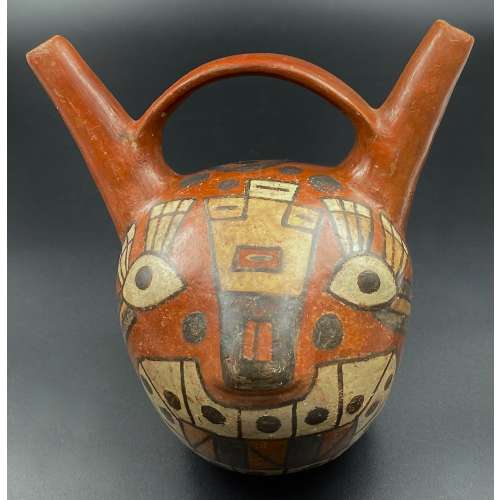 Pre-Columbian, Peru, Wari (Huari) culture, ca. 650 to 1000 CE.
Pre-Columbian, Peru, Wari (Huari) culture, ca. 650 to 1000 CE.A hand-built polychrome ceramic stirrup vessel depicting the head of a jaguar. Painted with a sienna-hued base, this spotted beast features an abstract visage of almond-shaped eyes opened wide with long feather-like lashes, a rectangular nose protruding from a nasal bridge decorated with a quadrilateral motif, and a large open mouth, showing both upper and lower teeth, which are also spotted, all painted in shades of cream, black, cream, grey, light grey, and beige. Highly burnished, the lustrous vessel exhibits two spouts, also functioning as ears of the jaguar, with a flat handle arching between them. This tool would have been a grave good intended to hold some kind of libation or offering and was likely made in a specialist workshop.
Colours: Sienna (base), black, cream, grey, light grey, beige (7 colours).
Dimension: Width (mouth-to-mouth): 15 cm; Height: 14.5 cm; Diameter of the body: 10.5 cm. Provenance: Hans Juergen Westermann collection, Germany. The Wari State was the first expansionistic power to develop in the Andean highlands. It was located in Vilcabamba, modern Espiritu Pampa (Plain of the Spirits), Echarate District of La Convención Province in the Cuzco Region of Peru. The Wari expanded around AD 650 and by the time of their collapse in AD 1000 they controlled much of the central Andes. -
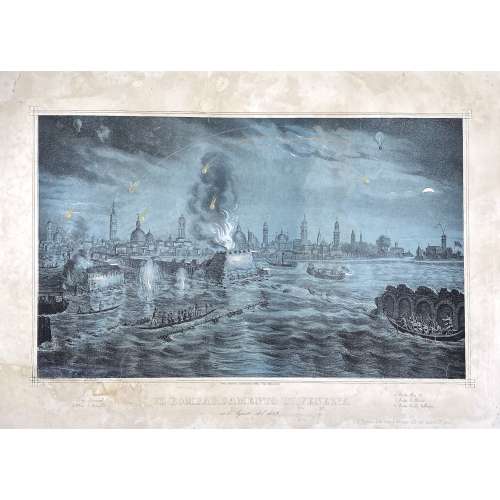 Quaritch's description: Single sheet (435 x 625 mm); coloured lithograph by Kirchmayr after a drawing by M. Fontana; hand-painted details; signed to lower left ‘M. Fon[tana]’ and to lower right ‘M. Fontana Edit. Prop. S. Giacomo dall’Orio in Isola N°.1481’; lower margin with the title ‘Il bombardamento di Venezia nell’Agosto 1849’ and key; restored tears in many places, especially along upper and lower blank margins, some affecting print; losses to lower left corner, affecting a small portion of the print, ruled border, and key, restored and re-drawn where needed; loss to the upper left corner of blank margin; two small areas of restoration to the centre of upper blank margin; the whole sheet backed; nevertheless a remarkable survival. Exceedingly rare and striking lithograph of Venice as seen from Fusina, depicting the first ever aerial bombardment in history. The bombardment took place in 1849, under the orders of Field Marshal Josef Radetzky (1766–1858), to quell the revolts that had started the previous year during the First Italian War of Independence. This curious and little-known action was the brainchild of Colonel Benno Uchatius, a brilliant young officer in the Austro-Hungarian Artillery. After long months of unsuccessful siege, Uchatius decided to deploy an unusual weapon: a hot air balloon able to bomb the city from above. Having calculated the wind speed and direction and evaluated the requisite dimensions of the hot-air balloon, Uchatius set up a workshop near Mestre, where a group of engineers and craftsmen began to manufacture a balloon equipped with a large wicker basket which could transport two crewmen and approximately one hundred kilograms of small long-fuse devices (metal spheres filled with gunpowder, pitch, oil and five hundred rifle buckshot). The initial trials, however, proved to be a disaster, because the balloon would drift off course, making it impossible to accurately deploy the bombs. Uchatius then hit upon the idea of using several smaller unmanned balloons roped together. These were to be launched over the city and, using the position of the first ‘pilot’ balloon, which was unarmed, the Austrians could calculate the correct fuse settings for the bombs. The ‘bomber’ balloons had a cloth envelope of one hundred cubic metres and a reduced load of about twenty kilograms of ordnance. According to Uchatius’ calculations, the line of balloons, launched from Mestre, would reach the lagoon city in thirty-five to forty minutes, carried by the north-west wind. In July 1849, a first launch was attempted, but when a breeze began to blow from the sea some of the balloons broke the connecting ropes and floated away, while others settled in the water in front of the northern part of the city, where a curious crowd of Venetians observed the failure of the enterprise and commented colourfully on the ‘buffoonery of Radetzky’. Uchatius’ second attempt, which is depicted in this lithograph, was also largely unsuccessful: only a few of the unmanned bomber balloons reached their target, and some even drifted back over the Austrian lines. Uchatius, having accomplished the first ever aerial bombardment, and having designed the first ever military ‘drones’, was forced to abandon the project permanently. Another fascinating aspect of this work is the vantage point used to depict the city of Venice, seen here from Fusina, a very rare viewpoint that makes this piece even more remarkable. We were unable to locate any copies in any institution or bibliography. G. Kirchmayr (fl. mid-19th century) is mentioned at British Museum database as "Lithographer active in Venice; related to Venetian painter Cherubino Kirchmayr (b. 1848)?" However, I was not able to find that name on the print. Not much is known of M. Fontana either.
Quaritch's description: Single sheet (435 x 625 mm); coloured lithograph by Kirchmayr after a drawing by M. Fontana; hand-painted details; signed to lower left ‘M. Fon[tana]’ and to lower right ‘M. Fontana Edit. Prop. S. Giacomo dall’Orio in Isola N°.1481’; lower margin with the title ‘Il bombardamento di Venezia nell’Agosto 1849’ and key; restored tears in many places, especially along upper and lower blank margins, some affecting print; losses to lower left corner, affecting a small portion of the print, ruled border, and key, restored and re-drawn where needed; loss to the upper left corner of blank margin; two small areas of restoration to the centre of upper blank margin; the whole sheet backed; nevertheless a remarkable survival. Exceedingly rare and striking lithograph of Venice as seen from Fusina, depicting the first ever aerial bombardment in history. The bombardment took place in 1849, under the orders of Field Marshal Josef Radetzky (1766–1858), to quell the revolts that had started the previous year during the First Italian War of Independence. This curious and little-known action was the brainchild of Colonel Benno Uchatius, a brilliant young officer in the Austro-Hungarian Artillery. After long months of unsuccessful siege, Uchatius decided to deploy an unusual weapon: a hot air balloon able to bomb the city from above. Having calculated the wind speed and direction and evaluated the requisite dimensions of the hot-air balloon, Uchatius set up a workshop near Mestre, where a group of engineers and craftsmen began to manufacture a balloon equipped with a large wicker basket which could transport two crewmen and approximately one hundred kilograms of small long-fuse devices (metal spheres filled with gunpowder, pitch, oil and five hundred rifle buckshot). The initial trials, however, proved to be a disaster, because the balloon would drift off course, making it impossible to accurately deploy the bombs. Uchatius then hit upon the idea of using several smaller unmanned balloons roped together. These were to be launched over the city and, using the position of the first ‘pilot’ balloon, which was unarmed, the Austrians could calculate the correct fuse settings for the bombs. The ‘bomber’ balloons had a cloth envelope of one hundred cubic metres and a reduced load of about twenty kilograms of ordnance. According to Uchatius’ calculations, the line of balloons, launched from Mestre, would reach the lagoon city in thirty-five to forty minutes, carried by the north-west wind. In July 1849, a first launch was attempted, but when a breeze began to blow from the sea some of the balloons broke the connecting ropes and floated away, while others settled in the water in front of the northern part of the city, where a curious crowd of Venetians observed the failure of the enterprise and commented colourfully on the ‘buffoonery of Radetzky’. Uchatius’ second attempt, which is depicted in this lithograph, was also largely unsuccessful: only a few of the unmanned bomber balloons reached their target, and some even drifted back over the Austrian lines. Uchatius, having accomplished the first ever aerial bombardment, and having designed the first ever military ‘drones’, was forced to abandon the project permanently. Another fascinating aspect of this work is the vantage point used to depict the city of Venice, seen here from Fusina, a very rare viewpoint that makes this piece even more remarkable. We were unable to locate any copies in any institution or bibliography. G. Kirchmayr (fl. mid-19th century) is mentioned at British Museum database as "Lithographer active in Venice; related to Venetian painter Cherubino Kirchmayr (b. 1848)?" However, I was not able to find that name on the print. Not much is known of M. Fontana either. -
 Artist: Utagawa Kunisada [歌川 国貞] a.k.a. Utagawa Toyokuni III [三代 歌川 豊国] (Japanese, 1786 – 1865). Signed: Kōchōrō Kunisada ga [香蝶楼国貞画] in a double-gourd cartouche. Iseya Sōemon [伊勢屋惣右衛門] (Japanese, 1776 – 1862); seal: Ue [上] (Marks 02-041 | 156a). Inscription in the red stripe: Five types of haiku in shōfū style [俳諧五流蕉風] (Haikai gōryū shōfū). Censor's seal: Watari [渡] (Watanabe Shōemon), VI/1842–V ic/1846. Media: Fan print [団扇絵] (Uchiwa-e); size: 225 x 292 mm. An uncut fan print depicts a young woman with an insect (firefly) cage in her left hand. Her striped kimono is adorned with the design of white, grey and blue cherry blossoms. Two of the Seven Grasses of Autumn [秋の七草] (aki no nanakusa), namely Platycodon grandiflorus (kikyō) [桔梗] a.k.a. Chinese bellflower (or balloon flower) and Patrinia scabiosifolia (ominaeshi) [女郎花] a. k.a. Eastern (or Golden) Valerian, are seen on her right-hand side.
Artist: Utagawa Kunisada [歌川 国貞] a.k.a. Utagawa Toyokuni III [三代 歌川 豊国] (Japanese, 1786 – 1865). Signed: Kōchōrō Kunisada ga [香蝶楼国貞画] in a double-gourd cartouche. Iseya Sōemon [伊勢屋惣右衛門] (Japanese, 1776 – 1862); seal: Ue [上] (Marks 02-041 | 156a). Inscription in the red stripe: Five types of haiku in shōfū style [俳諧五流蕉風] (Haikai gōryū shōfū). Censor's seal: Watari [渡] (Watanabe Shōemon), VI/1842–V ic/1846. Media: Fan print [団扇絵] (Uchiwa-e); size: 225 x 292 mm. An uncut fan print depicts a young woman with an insect (firefly) cage in her left hand. Her striped kimono is adorned with the design of white, grey and blue cherry blossoms. Two of the Seven Grasses of Autumn [秋の七草] (aki no nanakusa), namely Platycodon grandiflorus (kikyō) [桔梗] a.k.a. Chinese bellflower (or balloon flower) and Patrinia scabiosifolia (ominaeshi) [女郎花] a. k.a. Eastern (or Golden) Valerian, are seen on her right-hand side. -
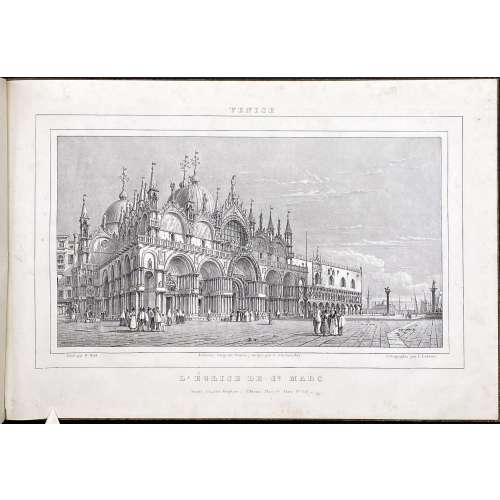 Owner's convolute binding of the period in quarter tan cloth, yellow marbled boards, no title page, no pagination. Contents: (1) Venetian Album –12 lithographs by Émile-Aubert Lessore (French, 1805 – 1876) after William Wyld (British, 1806 – 1889). — Venice: Charles Hopfner, [1834]. Printed at Premiata Litografia Veneta under the direction of Ferdinand Wolfgang Flachenecker (German, 1782 – 1847). Inscription: Premiata Litografia Veneta, dirigée par C. Flachenecker.
Owner's convolute binding of the period in quarter tan cloth, yellow marbled boards, no title page, no pagination. Contents: (1) Venetian Album –12 lithographs by Émile-Aubert Lessore (French, 1805 – 1876) after William Wyld (British, 1806 – 1889). — Venice: Charles Hopfner, [1834]. Printed at Premiata Litografia Veneta under the direction of Ferdinand Wolfgang Flachenecker (German, 1782 – 1847). Inscription: Premiata Litografia Veneta, dirigée par C. Flachenecker.- L'Église de St. Marc
- La place St. Marc
- Le palais Ducal
- Le Môle
- L'Arsenal
- La Riva dei Schiavoni
- Le Grand Canal, (1re vue)
- Le Grand Canal (2me vue)
- Le Grand Canal (3me vue)
- Le Grand Canal (4me vue)
- Le Grand Canal (5me vue)
- Le Grand Canal (6me vue)
- Title: Spiegazione / delli quattro prospetti dei bassi rilievi in marmo che circondano le mura della S. Casa di Loreto / qui annessi in puntata, oltre l'altro prospetto del palazzo pontificio / facciata del tempio, campanile, e cuppola etc.
- Prospetto della Basilica, e Piazza Lauretana, ed annesso Palazzo Apostolico / V. Jaffei incise.
- Settentrione. Prospetto laterale de Bassirilievi in Marmo, che circondano le Mura di S. Casa di Loreto. Jaffei incise Loreto.
- Oriente. Prospetto de Bassirilievi in Marmo, che circ=ondano le Mura di S. Casa. Jaffei incise Loreto l'Anno 1828.
- Mezzo Giorno. Prospetto laterale de Bassirilievi in Marmo, che circondano le Mura di S. Casa di Loreto. Jaffei dis. ed inc. in Loreto.
- Occidente. Prospetto de Bassirilievi in Marmo, che circ=ondano le Mura di S. Casa. Jaffei dis. ed inc. in Loreto l'Anno 1828.
-
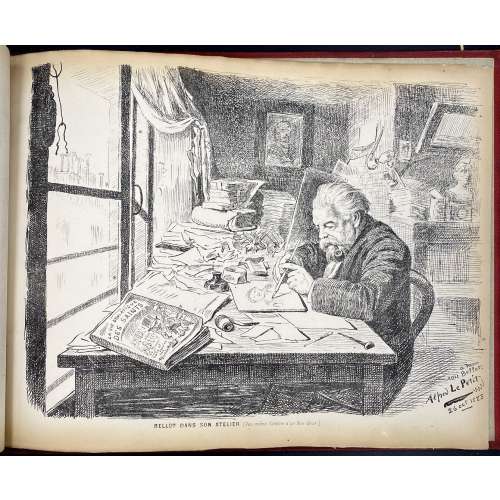 An album of the "Le Bon-Bock" dinners for the year 1884. Author, designer and publisher – Emile Bellot (French, 1831 – 1886), a Parisian artist and engraver. "Le Bon-Bock" was a monthly dinner of artists and men of letters, who gathered in Paris for good food, good company, and artistic performances, from 1875 to at least 1925. The story behind these gatherings as told by Emile Bellot, the founder, is this:
An album of the "Le Bon-Bock" dinners for the year 1884. Author, designer and publisher – Emile Bellot (French, 1831 – 1886), a Parisian artist and engraver. "Le Bon-Bock" was a monthly dinner of artists and men of letters, who gathered in Paris for good food, good company, and artistic performances, from 1875 to at least 1925. The story behind these gatherings as told by Emile Bellot, the founder, is this:In February 1875, Pierre Cottin1 came to me and said: 'I discovered a poet and tragedian of immense talent and who interprets the poems of the Great Victor Hugo in an astonishing way. Monsieur Gambini. I promised him that I would make it heard by an audience of artists and men of letters. I am counting on you who have many connections to keep my promise to him'. I gathered about 25 of my friends and acquaintances in a picnic dinner which took place at a restaurant 'Krauteimer' on the rue Rochechouart in Montmartre. They heard from Mr Gambini first, then my friends Étienne Carjat2, J. Gros3, Adrien Dézamy4, etc. performed. These gentlemen completed the evening so brilliantly that it was unanimously decided that we would start a similar dinner every month. Poets, musicians, men of letters, singers would be invited to this dinner. I was in charge of the organization of this little party and as it was the dream of my life to bring together old comrades, I was careful not to refuse and I pursued this good idea. Cottin and René Tener5 were kind enough to help me in this joyous task and especially my old friend Carjat. The following March began our 1st monthly dinner.
The name "Le Bon-Bock" means "The Good Bock", whilst Bock is a kind of beer, a dark, malty, lightly hopped ale. The dinner was named "Le Bon-Bock" in honour of the Éduard Manet painting (1873), a famous portrait of Emile Bellot, called "Le Bon-Bock".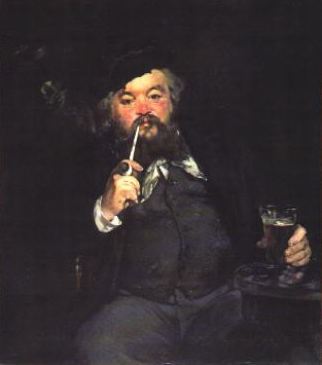 The invitations to the dinner were also produced by the artists and looked like this one by Alexandre Ferdinandus (October 3, 1883).
The invitations to the dinner were also produced by the artists and looked like this one by Alexandre Ferdinandus (October 3, 1883).
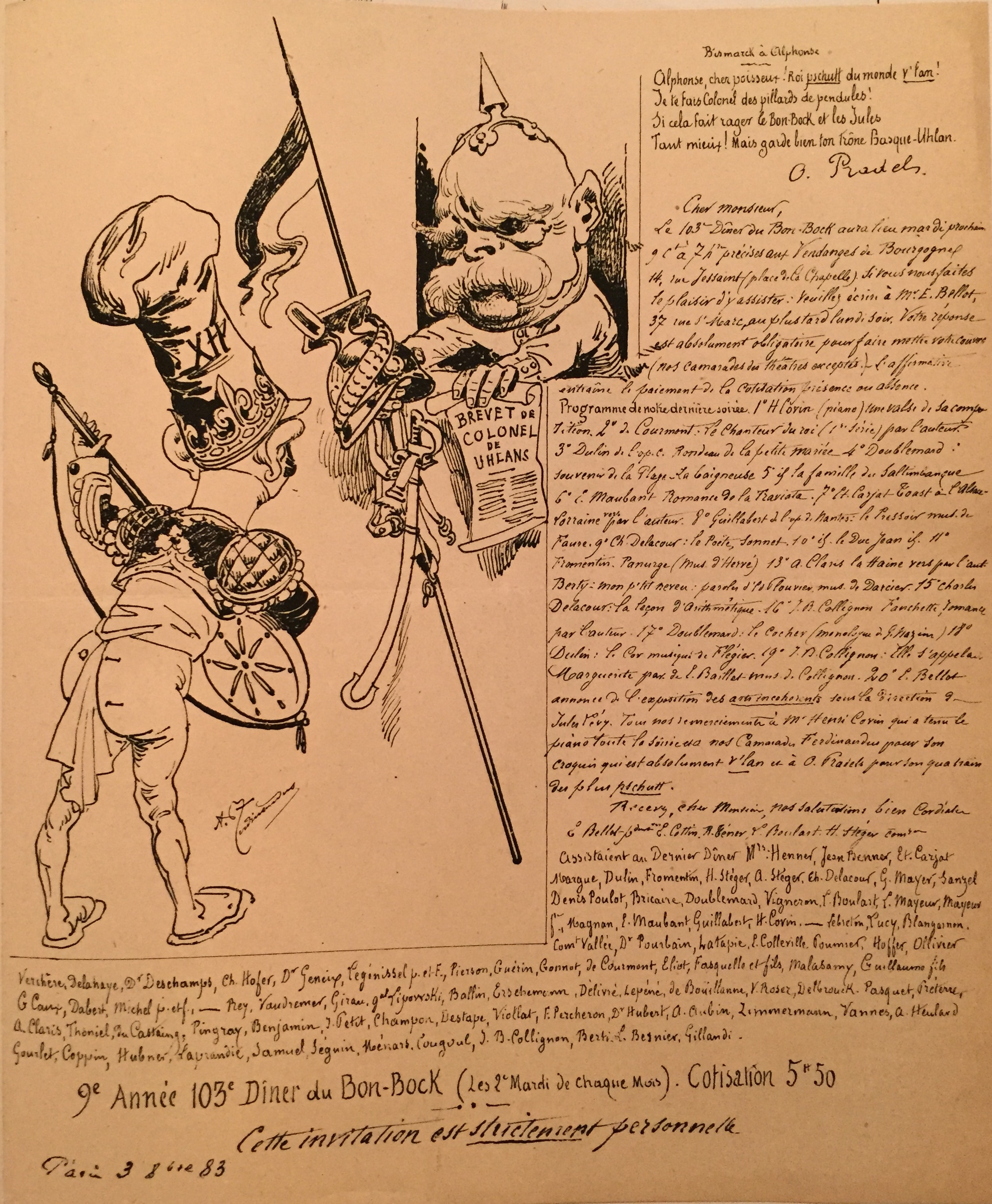 Besides this sketch of the Parisian social and artistic life at the end of the 19th century, the provenance of the album in our collection generates additional interest. The ink stamp to the front flyleaf reads: "Docteur Henry Uzan, 29 Avenue Perrichont, Paris XVI".
Doctor Henry Uzan was Jewish. He was arrested by the Pétain police on October 1, 1941, and interned in Drancy. With the few means at his disposal, he undertook to treat the sick whom he then saw leaving, week after week, towards their terrible destiny in the extermination camps. In October 1943 doctor Uzan was deported to the island of Alderney. After the Normandy Landing of June 6, 1944, Nazis evacuated the island detainees and transfer them to the Neuengamme camp, via northern France and Belgium. During the transfer, doctor Uzan managed to escape from the train on the night of September 3 to 4 around Dixmude in Flanders. He was taken in by the Belgian Resistance, which he joined before being repatriated to France.
In France, he continued working as a physician and was one of the founders of Association des internés et déportés politiques (AIDP). In 1945, together with his friends, the doctor designed the symbol for the Fédération nationale des déportés et internés résistants et patriotes:
Besides this sketch of the Parisian social and artistic life at the end of the 19th century, the provenance of the album in our collection generates additional interest. The ink stamp to the front flyleaf reads: "Docteur Henry Uzan, 29 Avenue Perrichont, Paris XVI".
Doctor Henry Uzan was Jewish. He was arrested by the Pétain police on October 1, 1941, and interned in Drancy. With the few means at his disposal, he undertook to treat the sick whom he then saw leaving, week after week, towards their terrible destiny in the extermination camps. In October 1943 doctor Uzan was deported to the island of Alderney. After the Normandy Landing of June 6, 1944, Nazis evacuated the island detainees and transfer them to the Neuengamme camp, via northern France and Belgium. During the transfer, doctor Uzan managed to escape from the train on the night of September 3 to 4 around Dixmude in Flanders. He was taken in by the Belgian Resistance, which he joined before being repatriated to France.
In France, he continued working as a physician and was one of the founders of Association des internés et déportés politiques (AIDP). In 1945, together with his friends, the doctor designed the symbol for the Fédération nationale des déportés et internés résistants et patriotes:
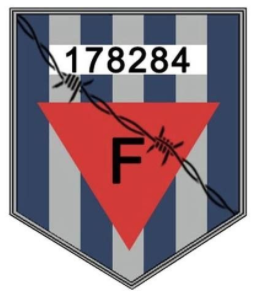 The story behind the number on the emblem (178284) is fascinating but it is out of the scope of this material.
The story behind the number on the emblem (178284) is fascinating but it is out of the scope of this material.
1. Pierre Cottin (French, 1823 – c. 1887) – Engraver, mezzotinter, genre and landscape painter; born in Chappelle-Saint-Denis (near Paris), a pupil of Jazet. Exhibited at the Salon from 1845, also in London from 1876 to 1879.↩ 2. Étienne Carjat (French, 1828 – 1906) – Journalist, caricaturist and photographer. ↩ 3. Jean Baptiste Louis Gros (French, 1793 – 1870) – Painter. ↩ 4. Adrien Dézamy (French, 1844 – 1891) – Writer, poet, general secretary of the Théâtre des Bouffes in Paris. ↩ 5. Rene Tener (French, 1846 – 1925) – Painter. ↩ Sources:Auguste Lepage. Les dîners artistiques et littéraires de Paris / Bibliothèque des Deux mondes (2e éd.) – Paris: Frinzine, Klein et Cie., 1884. [Accession № LIB-2606.2021 in this collection]


